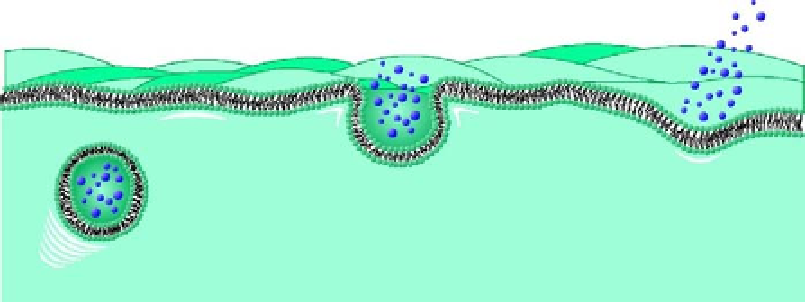Biomedical Engineering Reference
In-Depth Information
enough for responding to thousands of action potentials, where each vesicle stores approx-
imately 10,000 molecules of neurotransmitter in vesicles. The mitochondria supplies ATP to
resupply the vesicles with the neurotransmitter. The resupplying of the neurotransmitter
into the vesicles occurs even while the presynaptic neuron is delivering the neurotransmit-
ter into the synaptic gap during an action potential.
After an action potential reaches the presynaptic terminal, it depolarizes the membrane
and causes the movement of a few vesicles toward the membrane. Once in the vicinity of
the membrane, the vesicles then fuse with the membrane, as shown in Figure 12.38. This
process usually occurs in less than 1 ms. The fused vesicle then opens and the neurotrans-
mitter is released into the synaptic gap. This movement is not highly synchronized but
occurs in a random fashion. After moving through the synaptic gap by diffusion, the neu-
rotransmitter binds to a receptor in the postsynaptic neuron. The binding of the neurotrans-
mitter to the postsynaptic receptor causes a change in membrane potential, either
depolarization by an excitatory neurotransmitter, or hyperpolarization by an inhibitionary
neurotransmitter. This process usually occurs in less than 1 ms.
Note that there are a large number of presynaptic terminals (10,000 to 200,000) that con-
verge on the dendrite of a postsynaptic neuron. Each molecule of neurotransmitter causes a
change in membrane potential, which all sum according to superposition as described in
Example Problem 12.6. Note that synchronization is not essential because of the capacitive
nature of the membrane. The change in membrane potential at the postsynaptic dendrite
then travels to the soma as described in Section 12.5. If at the axon hillock the membrane
potential crosses threshold, an action potential is created that then moves without attenua-
tion down the axon, where the process repeats itself. If the membrane potential does not
reach threshold at the axon hillock, it then returns to the steady-state resting potential.
12.8.1 Calcium Ions
While the exact mechanism for the movement of the neurotransmitter vesicles to the pre-
synaptic terminal membrane and its release into the synaptic gap is unknown, it is believed
to involve voltage-gated calcium ion channels. The concentration of
Ca
þ2
is kept quite low
in the cytosol during periods of rest. When an action potential arrives at the presynaptic
FIGURE 12.38
The movement of the vesicle through the cytosol to the cell membrane, where it fuses and then
releases the neurotransmitter in the synaptic gap.


